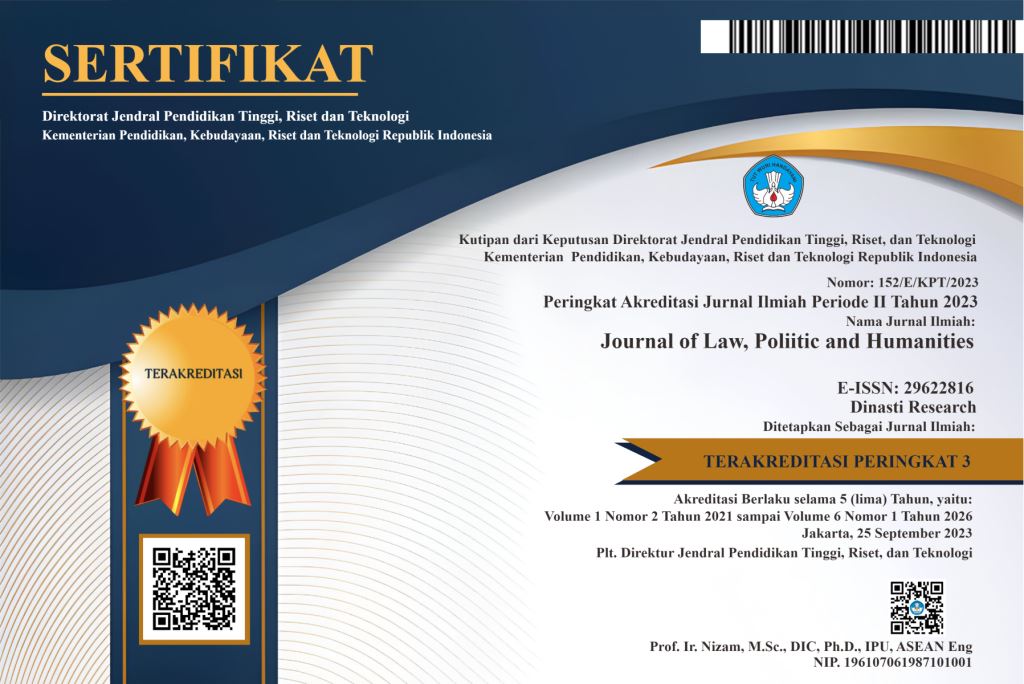Analysis of Living Organism in Arabic Vocabulary Meaning Perspective Biology and Lexical Meaning
DOI:
https://doi.org/10.38035/jlph.v3i2.177Keywords:
Arabic, Character, Gender, Living Organism, VocabularyAbstract
Most of Arabs people has spoken Arabic for communication. The Arabic word has a meaning to express feelings and interact socially. Lexical meaning in Arabic word has related to a specific of gender and a characteristic of living organism. The purpose of this study was to observed several meanings from the Arabic words and their relationship. In this study, semantic approach are used to analyze words lexically to find the meanings that indicate the characteristics and gender of living organism. The study found that the Arabic word has a real and a derivative meaning. As in the word father which in Arabic means Al-Abu, but it has a derivative meaning rooster. A rooster have similar character and behavior as a father in the role of the group and family member. Derivative meaning and reak meaning show that have a close relationship observed from characteristic and behavior of a living organism.
References
Akmaliyah. (2019). Equal Gender Analysis on the Meaning of Words Animal’s Appelation in Arabic. International Journal of Innovation, Creativity and Change, 122–132.
al-Ghalayyin, M. (2005). Jami ad-Durus al-’Arabiyah Jilid I. Beirut: Dar al-Kutub al-Islamiyah.
Amirifar, M., & Mottaqizadeh, E. (2018). Analysis of Correlation of Grammar and Meaning in Compilation of Fazel Saleh Allsameraei. Research in Arabic Language, 64.
Arnold, A. P. (2004). Sex Chromosomes and Brain Gender. Nature Review Neuroscience, 5, 701–708.
Baalbaki, R. (1995). Al-Mawrid A Modern Arabic-English Dictionary. Beirut: Dar El-Ilm Lilmalayin.
Bahar, M., Jhonstone, A., & Sutcliffe, R. (2010). Investigation of Students’ Cognitive Structure in Elementary Genetics Through Word Association Tests. Journal Biological of Education, 134–141.
Bhasin, S., Woodhouse, L., & Storer, T. (2001). Proof of the Effect of Testosterone on Skeletal Muscle. Journal of Endocrinology, 170, 27–38.
Bloomfield, L. (1993). Language. New York: Holt,Reinhart and Winston Inc.
Borreli, L., F, G., & G, F. (n.d.). Catalgue of Body Patterning in Cephalopoda. Stazione Zoologica A. Dohrn: Virenze University Press.
Borrelli, L., & G, F. (n.d.). In Learning and Memory: A Comprehenshive Reference (J. J. Byrne, ed.). Academic Press.
Champbell, N. A., Mitchel, L. G., & Reece, J. B. (2000). Biology: Concept & Connection. San Francisco: Benjamin/Cummings.
Dardjowijoyo, S. (2005). Psikolonguistik: Pengantar pemahaman Bahasa Manusia. Jakarta: Yayasan Obor Indonesia.
Dealing With Roosters Roo Behavior. (2017).
Echols, J. M., & Shadily, H. (2003). Kamus Inggris Indonesia: An English-Indonesian Dictionary. Jakarta: Gramedia Pustaka Utama.
Edwards, P., Felix, L., Harris, J., Ferguson, E., Free, C., Landon, J., & Murray, E. (2010). Assesing the Effectiveness and COst Effectiveness of Adaptive e-Learning to Improve Diatary Behaviour: Protocol for a Systematic Review. BMC Public Health.
Elrod, S., & Stansfield, W. (2007). Schaum’s Outline Teori dan Soal-soal: Genetika Edisi Keempat. Jakarta: Erlangga.
Farghal, M., & Kalakh, B. (2017). English Focus Structures in Arabic Translation: A Case Study of Gibran’s The Prophet. International Journal of Arabic-English Studies, 17, 233–251.
Gheibi, A., & Jahangiri Asl, M. (2019). A Semantic Study of Dhammah Vowel. Research in Arabic Language.
Ginting, M. L. B., & Herdiyana, R. (2020). Peran Pemerintah Pada Kebijakan Kartu Prakerja Dalam Memulihkan Kesejahteraan Pekerja Di Masa Pandemi Covid-19. Jurnal Analis Kebijakan, 4(2), 1–15.
Godfrey-Smith, P. (2017). The Mind of an Octopus. Scientific American Mind.
Hockett, C. (1958). A Course in Modern Linguistics. New York: MacMillan Company.
Hornby, A. S. (1989). Oxford Advances learner’s Dictionary of Current English. Amerika: Oxford University Press.
Izzan, A. (2015). Metodologi Pembelajaran Bahasa Arab. Bandung: Humaniora.
Jamilah, N. (2012). Semantic Translation Errors as a Result of Google Translate (A Case of Errors of Translations on Homonymous and Polysemous Words in Bahasa Indonesia. Diglossia: Jurnal Kajian Ilmiah Kebahasaan Dan Kesusastraan, 4(1).
Jewalani, A. P., Laksman-Huntley, M., & Anjaningsih, H. Y. (2019). Lexical Uniderstanding of Native Bahasa Indonesia Speakers through Word Association to Improve Dictionary Definitions. Lexikos, 29, 36–54.
Jupitasari, M., Saman, S., & Syahrani, A. (2014). Fungsi Semantik Kosakata Etnobotani Melayu Sukadana. Jurnal Pendidikan dan Pembelajaran Khatulistiwa.
Laza, S. R. (2018). Between Culture and Linguistic Approaches: English Versus Arabic. Studii de Stiinta Si Cultura, 72.
Mansour, F. (1996). Menggeser Konsepsi gender dan Transformasi Sosial. Yogyakarta: Pustaka Pelajar.
Mansur, A. A. (2018). Kontribusi Pragmatik dalam Penerjemahan: Peranan dan Fungsi Praktis. Diglossia: Jurnal Kajian Ilmiah Kebahasaan Dan Kesusastraan, 9(2).
Meikle, W. G., Weiss, M., & Beren, E. (2020). Landscape factors influencing honey bee colony behavior in Southern California commercial apiaries. Naturereaserch, 5013.
Memah, N. I., Rares, J., & Waleleng, G. (2022). Efektivitas Program Kartu Prakerja Era Pandemi Covid – 19 Di Dinas Tenaga Kerja Dan Transmigasi Daerah Provinsi Sulawesi Utara. Jurnal Agri-SosioEkonomi, 18(1), 247–254.
Munawwir, A. W. (1984). al-Munawwir: Kamus Arab-Indonesia. Yogyakarta: Pustaka Progresif.
Nixon, M., & Young, J. (2003). The Brains and Lives of Cephalopods. Oxford: Oxford University Press.
Omar, K. A. (2018). Gender in “Our Arabic Language” Books for the First Three Grades in Jordan. European Scientific Journal, 14(11), 59–79. https://doi.org/10.19044/esj.2018.v14n11p59
Ondang, G. L., Mingkid, E., & Tasik, F. C. . (2022). EFEKTIVITAS PROGRAM KARTU PRAKERJA BAGI FRESH GRADUATE DI KOTA MANADO. Jurnal Transdisipln Pertanian (Budidaya Tanaman, Perkebunan, Kehutanan, Peternakan, Perikanan), Sosial Dan Ekonomi, 18(2), 345–354.
Oueini, A., Awada, G., & Kaissi, F. S. (2020). Effect of Diglossia on Classical Arabic: Language Developments in Billingual Learners. GEMA Online Journal of Language Studies, 188–202.
Pamela, I., Shah, S. B., Makarenkova, H. P., & Fiorito, G. (n.d.). Nerve Degeneration and Regeneration in the Cephalopod Mollusc Octopus vulgaris: The Case of The Pallial Nerve. Nature.
Pateda, M. (2001). Semantik Lesikal. Jakarta: Rineka Cipta.
Priatna, T. (2020). Islamic Science: Theological Doctrine of Science Learning in Islamic Universities. International Journal Od Psychosocial Rehabilitation, 24, 973–980.
Rabiah, S. (2018). Language as a Tool for Communication and Cultural Reality Discloser. 1–11. https://doi.org/10.31227/osf.io/nw94m
Rahman, D., & Rahman, K. (2021). Efektivitas Kebijakan Pemerintah Tentang Pengembangan Kompetensi Kerja Melalui Program Kartu Prakerja Studi Program Kartu Prakerja Dalam Mengatasi Pengangguran Di Kabupaten Tebo Provinsi Jambi. Jurnal Kajian Pemerintah: Journal of Government, Social and Politics, 7(1), 39–53. https://doi.org/10.25299/jkp.2021.vol7(1).9717
Sherwood, L. (2002). Fisiologi Manusia : Dari Sel ke Sistem. Jakarta: EGC.
Souadkia, M. (2017). Comparative Study of Word-Order Patterns of Simpe Sentences in English and Arabic. RUDN Journal of Language Studies, Semiotics and Semantics, 486.
Stein, D. G. (2001). Brain Damage, Sex Hormones and Recovery: A New Role for Progesterone and Estrogen? Trend in Neurosciences (pp. 386–391). pp. 386–391.
Strurtevant, E. H. (2007). An Introduction to Linguistic Science. California: Read Book.
Suastini, N., & Ardiantari, I. (2019). English Interference Found in Indonesian Magazines. International Journal of Linguistics, Literature and Translation, 297–302.
Sugiarti, N., Wijaya, B., & Rosnija, E. (2014). A Discourse Analysis on Conversation of “TALK INDONESIA” on METRO TV. Jurnal Pendidikan Dan Pembelajaran Khatulistiwa, 3(7).
Taghanaki, F. S., Khazali, E., & Maleki, R. R. (2019). The Relationship between Form and Structure in The Theories Abdul-Ghaher Jorjani. Research in Arabic Language, 75.
Togia, A., & Malliari, A. (2017). Reasearch Methods in Library and Information Science. IntechOpen.
Yonata, F., & Mujiyanto, Y. (2017). The Representation of Gender in English Textbooks in Indonesia. Language Circle: Journal of Languae and Literature, 91–102.
Young, J. (1991). Computation in the Learning System of Cephalopods. The Biological Bulletin, 180, 200–208.
Young, J. Y. (1964). BRAIN AND BEHAVIOUR OF OCTOPUS: A model of The Brain.
Yusuf, K. O., & Omar, Z. (2012). مرفيمات اللغة العربية : ترتيبها وتنظيمها في الدرس اللغوس العربي. Journal of Linguistic and Literary Studies, 31.
Downloads
Published
How to Cite
Issue
Section
License
Authors who publish their manuscripts in this journal agree to the following conditions:
- The copyright on each article belongs to the author(s).
- The author acknowledges that the Journal of Law, Poliitic and Humanities (JLPH) has the right to be the first to publish with a Creative Commons Attribution 4.0 International license (Attribution 4.0 International (CC BY 4.0).
- Authors can submit articles separately, arrange for the non-exclusive distribution of manuscripts that have been published in this journal into other versions (e.g., sent to the author's institutional repository, publication into books, etc.), by acknowledging that the manuscript has been published for the first time in the Journal of Law, Poliitic and Humanities (JLPH).


























